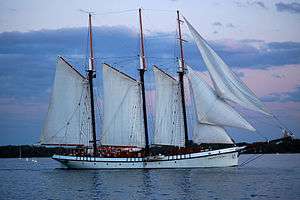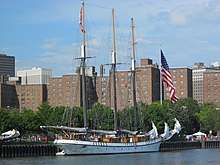Empire Sandy
Empire Sandy is a tall ship providing chartered tours for the public from Toronto, Canada. She was built as an Englishman/ Larch Deep Sea-class tugboat for war service by the British government in 1943.[4] After the end of World War II she was renamed Ashford and then Chris M before reverting to the original name of Empire Sandy and being converted to a schooner.
 Empire Sandy | |
| History | |
|---|---|
| Name: |
|
| Owner: |
|
| Operator: |
|
| Port of registry: |
|
| Builder: | Clelands (Successors) Ltd, Willington Quay on Tyne |
| Yard number: | 66 |
| Launched: | 22 December 1942 |
| Completed: | 14 July 1943 |
| Maiden voyage: | Iceland 30 July 1943 |
| Reclassified: | 1982 |
| Identification: |
|
| Status: | Active |
| General characteristics | |
| Class and type: |
|
| Tonnage: | |
| Displacement: | 740 tons (schooner) |
| Length: |
|
| Beam: | 30 ft 1 in (9.17 m) |
| Height: | 116 ft (35 m) (schooner) |
| Draught: | 15 ft 2 in (4.62 m) |
| Propulsion: |
|
| Sail plan: | Schooner (since 1982), Topsail schooner (since 2008) |
| Speed: | 16 knots (30 km/h) maximum under sail[3] |
| Capacity: | 275 passengers (since 1982) |
| Crew: | 25 (since 1982) |
| Armament: |
|
Tugboat history
Empire Sandy was one of 1,464 Empire ships built or acquired for war service by the British government.[4] Built in England in 1943 as a deep sea tugboat,[4] she was tasked with Royal Navy work and salvaging merchant ships damaged in the Battle of the Atlantic and other naval engagements during the Second World War. She served in the North Atlantic Ocean from Iceland to Sierra Leone, the Mediterranean Sea, the Indian Ocean and the Bay of Bengal during the Second World War.
Empire Sandy's Second World War 'Official Log-Books' documented all her wartime voyages. Of notable interest are the complete particulars of the crew, names, addresses, ages, next of kin etc. The oldest is the Master, E Thomas, 63, and the youngest is the Cabin Boy, Kenneth Lewis 15. These are in 'Log Book 014'. Another interesting entry is in TNA-25-5-05-094 describing the storm while towing, with His Majesty's Rescue Tug Hesperia, AFD24 (Admiralty Floating Drydock 24) off the coast of Libya on 8 February 1945. The tug Hesperia and AFD24 were both blown ashore and lost.
In 1948 she was bare-boat chartered by Risdon Beazley who renamed her Ashford.[4] Together with their Bustler-class tug Twyford, Ashford entered the rescue towage market.[5] Ashford is listed, in 'Part of the Acorn Archive – Hearts of Oak' as part of the salvage team attending the battleship HMS Warspite after Warspite went aground on 23 April 1947. Ashford is incorrectly identified as tug Englishman,[6] however all other particulars are of Ashford (Empire Sandy).[7]
Ashford was handed back to the Admiralty in 1952. She was then sold to a Canadian firm, the Great Lakes Paper Company, and renamed Chris M[8] (after Chris Michels, a senior employee of Great Lakes Paper[4]). She then came to the Canadian Great Lakes where she spent fifteen years towing timber rafts for Lake Superior logging companies. In the early 1970s the aged ship was to be sold for scrap, but the steel hull was still in very good condition and she was bought by Nautical Adventures Co. for a possible conversion. They completely rebuilt Chris M as a three-masted schooner in the style of the 1880s and she assumed her original name Empire Sandy .
On 5 August 2017, Empire Sandy was in collision with the Liberian freighter Ina at Port Colborne, Ontario.[9]

See also
Notes
- On 15 February 1965 Canada adopted a new flag.
- In 1970, the cities of Fort William and Port Arthur, and some townships, were merged to form the new City of Thunder Bay.
- Measured by onboard GPS while on passage New York to Bermuda running before hurricane Mitch Nov 1998
- Mitchell and Sawyer (1990) p. 304
- "Brook House Book – Home Page". risdonbeazley.co.uk.
- The tug Englishman was bombed and sunk on 21 January 1941
- "Hearts of Oak – Mount's Bay Visitors – HMS Warspite". ancestry.com.
- "Empire Sandy Chris M 1943". www.tynetugs.co.uk. Retrieved 22 July 2019.
- "Empire Sandy collides with freighter Ina". Maritime Herald. Archived from the original on 8 August 2017. Retrieved 7 August 2017.
References
- Mitchell, W H, and Sawyer, L A (1990). The Empire Ships. London, New York, Hamburg, Hong Kong: Lloyd's of London Press Ltd. ISBN 1-85044-275-4.
- Martin, Roy. "Risdon Beazley". Risdon Beazley. p. Post war. Retrieved 9 November 2009.
After the war they reduced their fleet to ten vessels including: Help & Lifeline, Foremost 17 & 18, and the tugs Ashford (Empire Sandy) & Twyford (HMS Warden on bare-boat charter)). In addition to salvage and wreck removal around the World they ventured into rescue towage and cargo recovery.
CS1 maint: ref=harv (link)
External links
| Wikimedia Commons has media related to Empire Sandy (ship, 1943). |